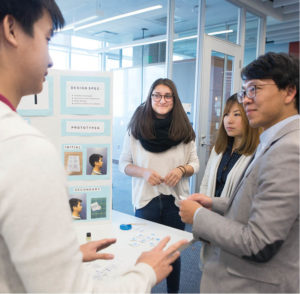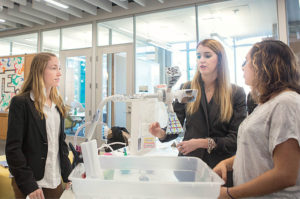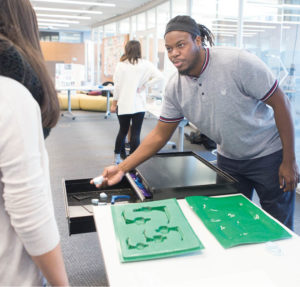For the past 15 years, David Owens, professor of the practice of management and innovation at the Vanderbilt Owen Graduate School of Management, has taught a course on New Product Design and Development, designed primarily for MBA candidates and engineering undergraduates—but available to any students with an interest in the subject.
With the recently opened makerspace at the Wond’ry, this year marked the first time the class was able to spend most of its time actually building and refining prototypes rather than taking in lectures and PowerPoint slides.
“It’s not surprising that the maker explosion is happening as our world goes more virtual,” Owens says. “It’s energizing to put something you made in front of people, and we never had the space before to do that very well.”
This year’s challenge: Design simple, low-cost solutions to various issues identified by the Monroe Carell Jr. Children’s Hospital at Vanderbilt. In December the 16 students in the class presented their prototypes in teams of four, answering probing questions from medical professionals and hospital administrators.
Cody Schmits, MBA’11, the hospital’s director of transformation and process integration, says the students never fail to impress. “We hope they’re able to bring these products to fruition so we can use them in serving our patients, family and employees.”
Here’s what they came up with:
 1. AROMATHERAPY PADS
1. AROMATHERAPY PADS
To help reduce workplace stress, students developed a stick-on aromatherapy pad that allows employees to breathe in lavender and eucalyptus. Plus, the designers say, the appearance of the pad itself could signal to colleagues that a person may need extra understanding and support.
 2. FERRIS-WHEEL MOBILES
2. FERRIS-WHEEL MOBILES
To design an infant mobile that’s entertaining and educational, but also easy to clean and remove, students took inspiration from a vertical Ferris wheel design. Austin Webster, a senior majoring in anthropology and cognitive studies, says she and her teammates quickly realized that engaging babies’ interest was more challenging than making the mobile easy to clean.
 3. VENTILATOR EQUIPMENT
3. VENTILATOR EQUIPMENT
Adetayo Ajayi, a senior engineering science major, showed visitors a better way to ensure that ventilator equipment is easy to access, sterilized and ready to use. All the tools fit precisely into a vacuum-formed plastic tray made in the Wond’ry, he says.
 4. IV-NEEDLE WINDOWS
4. IV-NEEDLE WINDOWS
Nurses spend an inordinate amount of time checking to be sure that IV needles inserted into the back of children’s hands stay put. Each time they check the site, a stabilizing guard must be removed and replaced. To remedy the problem, students developed a see-through window with an integrated LED light, allowing for easy nighttime checks that allow patients to keep sleeping.
—HEIDI HALL
PHOTOS BY SUSAN URMY